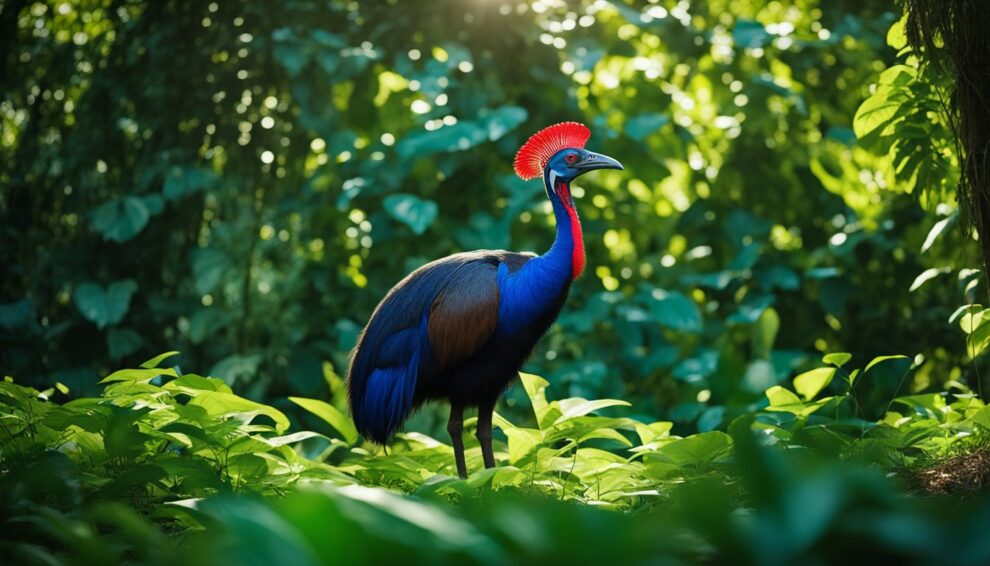Imagine wandering through the dense rainforests of Australia and encountering a creature that looks like it stepped right out from the pages of a prehistoric textbook.
Meet the cassowary, distinguished by its jet-black feathers, vibrant blue neck, and a helmet-like crest called a casque.
These flightless birds command attention with their formidable presence; they can stand up to six feet tall and possess powerful legs equipped with dagger-like claws.
While they are not creatures you’d want to cross paths with in a negative way, cassowaries are generally shy and would rather keep to themselves unless provoked.

Despite their elusive nature, cassowaries earn the title of the world’s most dangerous bird, and for good reason.
Their powerful legs can deliver swift and forceful kicks, and that sharp claw on each foot—reaching up to 12 centimeters in length—is capable of causing serious injury.
It’s a defense mechanism that has served them for thousands of years.
They’ve been part of the Earth’s tapestry for a long time, with early humans encountering these birds tens of thousands of years ago.
But how often do these powerful birds actually interact with humans, and why should we give them space and respect in the wild?
Have you ever wondered what it would be like to discover a dinosaur-era egg?
People in New Guinea did something similar nearly 18,000 years ago when they came across cassowary eggs.
Unlike finding dinosaur eggs, these were from very much living, breathing, and hopefully not too disgruntled birds.
The relationship between humans and cassowaries has evolved since then.
Instead of ending up as an item on the menu, these remarkable birds have sparked our curiosity and admiration, reminding us that even the most dangerous creatures have a place in the ecosystem and a story worth sharing.
Mysteries of the Cassowary
Cassowaries, with their commanding presence and mystical aura, hold secrets dating back millions of years and pose questions that stir the curiosity of both scientists and enthusiasts alike.
From tales woven into the fabric of indigenous cultures to the unique physical attributes that set them apart from other birds, each facet of the cassowary’s life is a piece of the puzzle that is as enigmatic as it is intriguing.
Cassowaries in Culture and History
These birds command reverence, often characterized as formidable beings within indigenous folklore.
The cassowary’s role in the cultures of New Guinea and northeastern Australia is steeped in rituals and legends.
It’s often believed that the spirits of ancestors and otherworldly beings are intertwined with the existence of these towering birds.
Artifacts and totemic images showcase the cassowary’s imprint on human lives, reaffirming its significance beyond just a forest-dweller.
Physiology: From Feathers to Feet
Speaking of which, have you ever wondered about the cassowary’s vibrant feathers or its helmet-like casque?
Each feather, a fusion of brilliant colors—shades of black, azure, and crimson—plays a role in more than just appearance.
The structure of these feathers can offer protection and aid in camouflage within the dense rainforest habitats they call home.
Meanwhile, the casque, a helmet-like structure made of keratin, still puzzles scientists.
Some believe it might be used in pushing aside forest underbrush or for attracting mates.
Now, imagine running with powerful legs that end in feet equipped with claws that inspire comparisons to dinosaurs.
They have three toes, but it’s the inner toe that sports a blade-like claw measuring up to 12 centimeters long—a tool that, combined with their size and strength, can become a formidable weapon when necessary.
The cassowary is a master of its domain—flightless yet far from defenseless.
Observing the interplay between its physical traits and behaviors brings to light a spectrum of adaptations crafted by evolution, each speaking of survival tactics refined across the ages.
These rainforest ambassadors belong to a group of birds known as ratites, which also includes the ostrich and the emu.
Among the three known species—the southern, dwarf, and northern cassowaries—size and territory differ, with the southern cassowary being the largest and most widely recognized.
They’re a window into prehistoric times, an embodiment of nature’s marvels in feathers and flesh.
Habitat and Diet

Cassowaries are not just any bird you might find at your local park; these creatures are truly unique in where they call home and what they munch on.
Let’s take a closer look at the environments where these birds thrive and their food preferences.
Where Do Cassowaries Live?
Imagine wandering through a thick, humid rainforest in Australia or New Guinea, where sunlight filters through the dense canopy above.
This is where you’d typically find a cassowary, making its way through a lush habitat.
These large, flightless birds favor the shadowy understory of rainforests, but they’re also known to explore other areas.
Picture them strolling along a beach or navigating through woodlands and mangrove swamps. Can you see them amid the tangle of roots and vibrant greenery?
Cassowaries play a crucial role in this ecosystem and prefer to stay within the lowland regions, mostly keeping below elevations of 1,000 meters.
What’s on the Menu?
Have you ever wondered what a day in the life of a cassowary might taste like? Their diet is as intriguing as their appearance.
These birds are primarily frugivores, meaning fallen fruit is their go-to treat.
Think of them as the cleanup crew of the forest floor, gobbling up fruits that other animals might overlook, in turn helping to disperse seeds and keep the forest alive.
But that’s not all they eat – when they’re feeling peckish, they’ll snack on a variety of insects too.
Each meal a cassowary enjoys helps keep their rainforest home thriving and full of life.
Have you ever thought that by just eating lunch, you could be helping an entire forest grow?
In their lush, green world, cassowaries are less like birds and more like gardeners, tirelessly working to maintain the delicate balance of their ecosystem.
As they stride through their rainforest home, they’re not only searching for their next fruity feast but also ensuring that the forest continues to flourish around them.
It’s a fine dining experience with a purpose, wouldn’t you agree?
Interaction with Humans and the Environment

Cassowaries, though primarily shy and reclusive, can become aggressive when they feel threatened by humans or when their habitat is disturbed.
The balance between human activity and the conservation of these birds is crucial.
Cassowaries and Human Encounters
In the lush rainforests of Australia and New Guinea, encounters between humans and cassowaries can sometimes lead to dangerous situations.
When cassowaries feel cornered or perceive humans as a threat, they can exhibit aggressive behavior.
Quick and capable of inflicting serious injuries with their sharp claws, cassowary attacks, although rare, have been documented.
In some areas, people are encouraged not to feed these wild birds, as this can lead to them associating humans with food, potentially increasing the likelihood of aggressive interactions.
Science has played a pivotal role in educating the public on safe practices to reduce conflicts between cassowaries and people.
Conserving the Elusive Cassowaries
The conservation status of cassowaries is alarming; they are considered endangered.
Researchers are continuously studying these birds to understand their behavior, population dynamics, and ecology to inform conservation efforts.
With deforestation and habitat loss posing significant threats to their survival, wildlife conservationists are working to protect the remaining populations.
It’s a delicate task that requires a synergy of scientific research and community cooperation to ensure the cassowaries’ habitat is preserved.
Protecting these majestic birds not only benefits their survival but also supports the health of the environment, as cassowaries are known to be keystone species, playing a critical role in seed dispersal and forest regeneration.
Reproduction and Lifecycle
To truly understand cassowaries, it helps to peek into their life from the very start.
These large, flightless birds have a unique reproductive process and growth cycle that raises curiosity and wonder.

From Eggs to Independence
The breeding season of the cassowary is marked by the intricate dance of attraction between males and females.
Once a match is made, the female deposits her eggs in a nest which is not much more than a simple scrape in the ground, often lined with leaves.
Typically, the nest is a shallow pit the male bird digs into the earth, though it may seem modest, this is the cradle of new life.
These vibrant, glossy-green eggs are quite the spectacle. Could you imagine holding one? They’re enormous, each one the size of a mango!
After the female cassowary has laid her eggs, often ranging from three to eight in a clutch, she departs, leaving the dedicated male bird to take on the challenge of incubation.
Now, picture the male cassowary, a model father he is, as he settles in for the long haul.
For about 50 days, he will not eat much, he won’t stray far, and he’ll incubate those precious eggs with a warmth and constancy that rivals the sun.
His large, feathered body acts as a natural blanket, protecting the future chicks from any harm.
Once the chicks break through their shells, the world they encounter is under the watchful eye of their dad.
These fluffy, brown-striped youngsters are precocial, meaning they are up and about, ready to conquer the world—or at least the rainforest—shortly after hatching.
The father doesn’t just stop at keeping them warm; he is their teacher, their guardian, their guide.
Isn’t it fantastic how he shows them the ropes, finding food and dodging danger?
While the chicks follow their father, mimicking his every move, they’re learning the art of survival.
This period of dependence lasts for about nine months.
Can you imagine spending every moment of nine whole months with your dad, like a shadow in his footsteps?
After this intense parenting period, they venture off to lead solitary lives, just like other cassowaries, perhaps someday raising their own broods in the cycle of life that continues deep in the forest.
Frequently Asked Questions

Discover the quirks and qualities that place the cassowary at the top of the list of the world’s most dangerous birds.
These questions reveal fascinating traits and behaviors that set this avian apart.
Why are cassowaries considered dangerous to humans?
Cassowaries are known for their unpredictable nature, particularly when feeling threatened.
They have been involved in incidents causing harm to humans due to their powerful kick, sharp claws, and ability to charge at rapid speeds.
What features make the cassowary a formidable bird?
Standing up to six feet tall, the cassowary boasts a helmet-like casque on its head and vibrant blue and red plumage.
Strong legs and a middle toe with a dagger-like claw make it extremely adept in a confrontation.
How does the cassowary’s claw differ from those of other birds?
The cassowary’s middle claw is exceptionally long, reaching lengths of up to 4.75 inches.
This lethal weapon, vastly different from the smaller claws of most birds, serves as a formidable tool for defense and asserting dominance.
In what ways are cassowaries similar to and different from emus?
Cassowaries and emus both possess impressive size and flightlessness, characteristic of ratites.
However, emus lack the colorful head and neck features and the prominent casque that cassowaries display.
What role does territory play in the behavior of cassowaries?
Territorial behavior plays a crucial part in a cassowary’s life.
They fiercely protect their space, especially during breeding seasons, which can lead to aggressive encounters if they perceive an invasion.
Can you explain how cassowaries have evolved over time?
Cassowaries have adapted through the ages, evidence of which can be seen in their robust bodies suited for dense rainforest living.
Their casque may have evolved for pushing through thick underbrush or as a means of displaying dominance.









